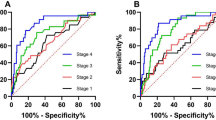Abstract
Background
The Japanese severity score (JSS) for acute pancreatitis was revised in 2008. As special therapies for severe acute pancreatitis (SAP), continuous regional arterial infusion of protease inhibitor and antibiotics (CRAI) and enteral nutrition (EN) are now utilized in Japan. We investigated the usefulness of the new JSS and the indications for CRAI and EN based on the new JSS.
Methods
We assessed the new JSS in 138 patients with SAP according to the previous Japanese criteria. Usefulness of the new JSS for the prediction of mortality rates was compared with conventional scoring systems by receiver-operator characteristic curve analysis. We analyzed the relationship between the new JSS and prognosis in patients with and without CRAI and EN, respectively.
Results
Forty-five patients (33%) were assessed as having mild acute pancreatitis, and 93 patients (67%) were assessed as having SAP. Their mortality rates were 7 and 40%, respectively. The area under the curve for the prediction of mortality rates with the new JSS was 0.822 and was the highest among conventional scoring systems. In patients with new JSS ≥ 6, the mortality rate was lower in patients with CRAI than in patients without CRAI (P = 0.129). In patients with new JSS ≥ 4, the mortality rate was lower in patients with EN than in patients without EN (P = 0.016).
Conclusions
The new JSS is useful and easier to use for the prediction of prognosis compared to the conventional scoring systems. EN was effective in reducing the mortality rate in patients with a new JSS ≥ 4.






Similar content being viewed by others
References
Nathens AB, Curtis JR, Beale RJ, Cook DJ, Moreno RP, Romand JA, et al. Management of the critically ill patient with severe acute pancreatitis. Crit Care Med. 2004;32:2524–36.
Sekimoto M, Takada T, Kawarada Y, Hirata K, Mayumi T, Yoshida M, et al. JPN guidelines for the management of acute pancreatitis: epidemiology, etiology, natural history, and outcome predictors in acute pancreatitis. J Hepatobiliary Pancreat Surg. 2006;13:10–24.
Ranson JH, Rifkind KM, Roses DF, Fink SD, Eng K, Spencer FC. Prognostic signs and the role of operative management in acute pancreatitis. Surg Gynecol Obstet. 1974;139:69–81.
Blamey SL, Imrie CW, O’Neill J, Gilmour WH, Carter DC. Prognostic factors in acute pancreatitis. Gut. 1984;25:1340–6.
Knaus WA, Draper EA, Wagner DP, Zimmerman JE. APACHE II: a severity of disease classification system. Crit Care Med. 1985;13:818–29.
Saitoh Y, Yamamoto M. Evaluation of severity of acute pancreatitis. According to a report of the cooperative national survey in Japan. Int J Pancreatol. 1991;9:51–8.
Ogawa M, Hirota M, Hayakawa T, Matsuno S, Watanabe S, Atomi Y, et al. Development and use of a new staging system for severe acute pancreatitis based on a nationwide survey in Japan. Pancreas. 2002;25:325–30.
Takeda K, Takada T, Kawarada Y, Hirata K, Mayumi T, Yoshida M, et al. JPN guidelines for the management of acute pancreatitis: medical management of acute pancreatitis. J Hepatobiliary Pancreat Surg. 2006;13:42–7.
Takeda K, Matsuno S, Sunamura M, Kakugawa Y. Continuous regional arterial infusion of protease inhibitor and antibiotics in acute necrotizing pancreatitis. Am J Surg. 1996;171:394–8.
Takeda K, Yamauchi J, Shibuya K, Sunamura M, Mikami Y, Matsuno S. Benefit of continuous regional arterial infusion of protease inhibitor and antibiotic in the management of acute necrotizing pancreatitis. Pancreatology. 2001;1:668–73.
Takeda K, Matsuno S, Ogawa M, Watanabe S, Atomi Y. Continuous regional arterial infusion (CRAI) therapy reduces the mortality rate of acute necrotizing pancreatitis: results of a cooperative survey in Japan. J Hepatobiliary Pancreat Surg. 2001;8:216–20.
Imaizumi H, Kida M, Nishimaki H, Okuno J, Kataoka Y, Kida Y, et al. Efficacy of continuous regional arterial infusion of a protease inhibitor and antibiotic for severe acute pancreatitis in patients admitted to an intensive care unit. Pancreas. 2004;28:369–73.
Kalfarentzos F, Kehagias J, Mead N, Kokkinis K, Gogos CA. Enteral nutrition is superior to parenteral nutrition in severe acute pancreatitis: results of a randomized prospective trial. Br J Surg. 1997;84:1665–9.
McClave SA, Greene LM, Snider HL, Makk LJ, Cheadle WG, Owens NA, et al. Comparison of the safety of early enteral vs parenteral nutrition in mild acute pancreatitis. JPEN J Parenter Enteral Nutr. 1997;21:14–20.
McClave SA, Chang WK, Dhaliwal R, Heyland DK. Nutrition support in acute pancreatitis: a systematic review of the literature. JPEN J Parenter Enteral Nutr. 2006;30:143–56.
Yasuda T, Ueda T, Takeyama Y, Shinzeki M, Sawa H, Nakajima T, et al. Treatment strategy against infection: clinical outcome of continuous regional arterial infusion, enteral nutrition, and surgery in severe acute pancreatitis. J Gastroenterol. 2007;42:681–9.
Lusted LB. Decision-making studies in patient management. N Engl J Med. 1971;284:416–24.
Robertson EA, Zweig MH. Use of receiver operating characteristic curves to evaluate the clinical performance of analytical systems. Clin Chem. 1981;27:1569–74.
Toouli J, Brooke-Smith M, Bassi C, Carr-Locke D, Telford J, Freeny P, et al. Guidelines for the management of acute pancreatitis. J Gastroenterol Hepatol. 2002;17(Suppl):S15–39.
Working Party of the British Society of Gastroenterology, Association of Surgeons of Great Britain and Ireland, Pancreatic Society of Great Britain and Ireland, Association of Upper GI Surgeons of Great Britain and Ireland. UK guidelines for the management of acute pancreatitis. Gut. 2005;54(Suppl 3):1–9.
Bradley EL 3rd. A clinically based classification system for acute pancreatitis. Summary of the international symposium on acute pancreatitis, Atlanta, GA, September 11 through 13, 1992. Arch Surg. 1993;128:586–90.
Dervenis C, Johnson CD, Bassi C, Bradley E, Imrie CW, McMahon MJ, et al. Diagnosis, objective assessment of severity, and management of acute pancreatitis. Santorini consensus conference. Int J Pancreatol. 1999;25:195–210.
Acknowledgments
This investigation was supported by a grant-in-aid for scientific research from the Ministry of Education, Science, Sports and Culture of Japan, and from the Ministry of Health, Labor and Welfare of Japan.
Author information
Authors and Affiliations
Corresponding author
Rights and permissions
About this article
Cite this article
Ueda, T., Takeyama, Y., Yasuda, T. et al. Utility of the new Japanese severity score and indications for special therapies in acute pancreatitis. J Gastroenterol 44, 453–459 (2009). https://doi.org/10.1007/s00535-009-0026-x
Received:
Accepted:
Published:
Issue Date:
DOI: https://doi.org/10.1007/s00535-009-0026-x




